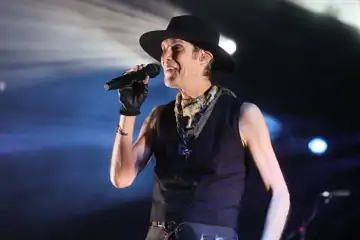 Cody ChesnuTT
Cody ChesnuTTIn 2002, Cody ChesnuTT released The Headphone Masterpiece, a self-recorded and, initially, self-released LP that was one of the first 'success stories' of the nascent file-sharing era. The record's presumptive title showed the Atlanta-born artist's ambition, but also gave a sly nod to the way it was made: at home, by himself, on a primitive four-track recorder. The album had a built-in narrative – ChesnuTT tried all manner of tricks to 'promote' his record, from giving it away at the shows of other artists to inviting strangers back to his house to listen to it – that made for good copy, and its sprawling, double-album scrapbook felt like the work of an artist bursting with ideas. Soon after, ChesnuTT remade the LP cut, The Seed, with The Roots, began touring the world with them and seemed an upwardly mobile artist; a black-rocker with soul roots, hip hop friends and a lo-fi sound. Only, then, he essentially vanished. He turned up, briefly, in Michel Gondry's documentary, Dave Chapelle's Block Party, but for years ChesnuTT was an unexpected recluse. In truth, he'd moved to Tallahassee, Florida, wanting to start a family far from the music industry. On the phone from his hometown, ChesnuTT, now 45, identifies the slow pace of life in Tallahassee as its chief appeal. “I had a blast travelling the world, touring through countries I'd never been to, getting to perform with The Roots. But I was born and raised in the South in Atlanta, Georgia, and there's a big part of me that's always drawn back to the South.”
ChesnuTT was raised on the record collection of his family. “I grew up around the music of the '60s and '70s. I was born in '68, and I caught on pretty early. The whole Motown movement, old funk and soul, this great, socially-conscious musical movement. I got all of that stuff early. It felt like it was my own education: listening to the soul records of my parents, or the classical records that my grandmother and great uncle would listen to. It taught me so much about the world.”
ChesnuTT started playing drums at five and piano at eight, but it was only when he was 11 that he started wanting to make his own music. The inspiration came with the release of Off The Wall in 1979. “It was Michael Jackson, like with so many other kids, that turned the light on for me. That was the beginning, when the buzz really hit me. I realised there was something really natural about performance, about expressing yourself and communicating yourself through music. And it made me pay attention to the details: I'd never actually picked up an album and read all the liner notes and the production credits before Off The Wall. But that album turned me into a student of the craft.”
His lifetime of study eventually led ChesnuTT to second album, last year's 'comeback set' Landing On A Hundred, arriving a whole decade after his debut. After the scratchy, home-recorded, soul-by-way-of-Guided By Voices sound of The Headphone Masterpiece, ChesnuTT's second set introduced something far different: a set of classic-sounding soul fitted out in warm instrumentation and big arrangements. It was again recorded on analogue tape, but this time on the vintage reel-to-reel tape machines of Royal Studios in Memphis, the place Al Green called home in the '70s, and in recent years a shrine for everyone from My Morning Jacket to Cliff Richard looking to evoke that old-soul sound. “Believe it or not, Memphis, Royal Studios, was, like, a last-minute decision. We were just looking for a studio that had analogue recording equipment, for the best rate,” ChesnuTT laughs. “But, when we got there, we realised, 'Wow, this place is the foundation of what it is we're aspiring to do right now. All these great soul classics from Memphis – Al Green, Ike & Tina Turner – they had that spirit that we wanted, and that spirit was definitely in that place. You could feel it in the wallpaper, in the paint; there was something indefinable in there, something that was greater than just the energy and performances that you could put on a record... When we were there, Lamont Dozier, one of the great writers from Holland-Dozier-Holland, the writing team behind so many classic Motown singles, was there, and we got to talk to him. There was this real sense that this history that had informed my music was alive around us.”
The initial inspiration came, for ChesnuTT, from hearing young people lament that there was no contemporary equivalent to the socially-conscious soul record of the '70s. “I heard a lot of people saying, 'Why aren't artists these days making music like this? Why doesn't our generation have people who are making albums this deep, this true, this socially-minded? Why don't we have anything today that can make us feel this way?' And I found myself in concert with those ideas; that's how I feel.”















